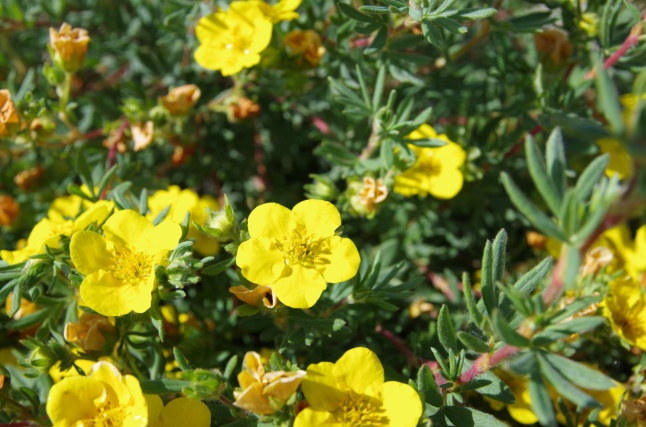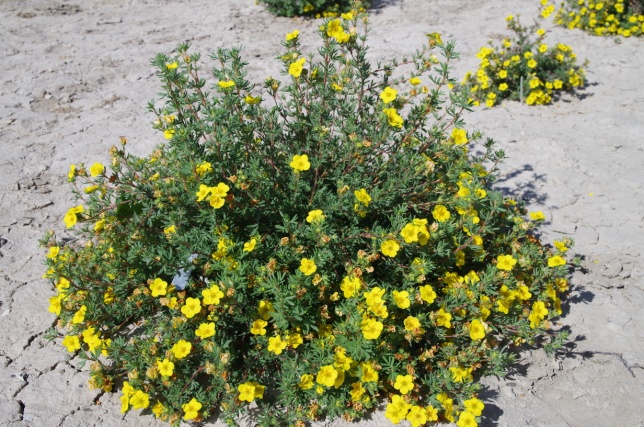Shrubby Cinquefoil in the Landscape


Stephen Love, University of Idaho
Scientfic Name: Dasiphora fruticosa ssp. floribundaCommon Name: (syns. Potentilla fruticosa ssp. floribunda, Dasiphora floribunda, Potentilla floribunda)
Shrubby cinquefoil, shrubby five-finger, tundra rose
Description: Shrubby cinquefoil is a tough but a colorful landscape shrub. The species is variable for plant size and form, at its tallest growing to 5 feet, at its shortest being nearly prostrate. Plants are usually more broad than they are tall. The leaves are medium green to gray-green and palmately divided into five leaflets. The sunny, five-petaled, one inch flowers provide the primary appeal for this species. Bloom is profuse with flowers covering the plants from early spring until hard frost in the fall. Despite its tendency to inhabit vernally moist or flooded sites in nature, this is a very drought tolerant plant. It makes an excellent specimen or repetitive element in a xeric landscape.
Native Habitat: Shrubby cinquefoil is a widespread and adaptable species found in all western states and stretching east through the upper Midwest into the northeastern region of the country. Western forms inhabit vernally moist sites, peat bogs, dry shrub-steppe communities, and rocky exposed high elevation ridges. Shrubby cinquefoil can become the dominant species in some plant communities, such as fescue meadows and willow-peat bogs. Intermountain West habitats for shrubby cinquefoil cover a remarkable range in elevation, 2,700 to 13,200. A second subspecies (Dasiphora fruticosa ssp. fruticosa) is native to mountainous regions of Europe and Asia.
Cultural Requirement
Soil: Tolerant of a wide range of soils, including heavy clays and seasonally flooded soils. Plants from western US regions withstand moderately saline soils and those with very high pH.
Moisture Tolerance: Tolerates in a wide range of moisture conditions, from xeric to moderately moist. Performs best, and flowers longest, if provided regular supplemental irrigation in summer.
Sun/Shade/Preference: Prefers full sun but will grow and flower adequately in part shade.
Transplanting: Seedlings of shrubby cinquefoil are easily transplanted both from pot to pot and from pot to garden. Plants grow well in pot culture and make good subjects for 1-gallon or 5-gallon containers.
Propagation: Shrubby cinquefoil can be propagated either by seed or vegetative cuttings. Seed requires an 8 week stratification period for maximum germination. Poor germination may still be expressed by some seed lots. Softwood cuttings taken in July can be rooted under mist in perlite:peat or sand media. A 1,000 ppm IBA dip enhances rooting which takes about three weeks.
Maintenance (pruning, fertilization, deadheading, division, irrigation, etc): Spring trimming to remove tip winter injury and old seed heads improves appearance. Otherwise, plants of shrubby cinquefoil are relatively care-free. Although regular watering is not essential, irrigation scheduled once every 10 days to 2 weeks during the heat of summer will improve appearance. Compact form is maintained under low fertility conditions, but plants may benefit from an occasional light application of fertilizer to increase vigor.
Insect, disease, or other problems: Shrubby cinquefoil has few insect or disease issues. Spider mites may occasionally reduce attractiveness of the foliage but can be controlled by spraying the foliage with a directed stream of water or by applying an insecticidal soap product.
Landscape Value
Use in the Landscape: Flowers of shrubby cinquefoil contribute constant color in the landscape. This species is valuable as a repetitive element in any part of the landscape and to provide accent to other plants. It can be used for foundation plantings, to create a short hedge, or planted as a groundcover to stabilize a slope. Prostrate forms may be utilized to decorate rock gardens and terraces. Shrubby cinquefoil can be effectively used in either formal or naturalized landscapes.
Weediness/Invasive Potential: Shrubby cinquefoil is non-rhizomatous and is not weedy from seed, although it will produce occasional volunteer seedlings. This species is not invasive.
Foliage: Branches of shrubby cinquefoil are supple and slender and tend to droop at the ends. The gray-brown bark peels and shreds with age. Leaves are deciduous, medium green to gray-green, and palmately divided into 5 small leaflets. Foliage is dense and gives the plants mounded form.
Flower: The profuse flowers grow in small terminal clusters. Flowers have five petals, are ½ to 1 inch in diameter, and bright yellow in color. Corolla shape is typical of species in the rose family. Bloom lasts from mid-spring to late fall but is heaviest in early summer.
Timing: May-October.
Fruit: The fruits are composite like the related strawberry, but are dry rather than fleshy. Fruits are comprised of individual small, tan, oval seeds.
Form: Small shrub with dense to open mounding or prostrate form.
Texture: Fine to medium, depending on time of year.
Ultimate Size: Mature size is dependent on provenance. Plants collected from moist sites at lower elevations are typically 3 to 5 feet tall and 4 to 6 feet wide. Plants collected from higher or drier sites may have a maximum height of less than one foot.
Rate of Growth: Shrubby cinquefoil grows moderately fast, whether established as seedlings or cuttings. Plants often begin blooming in pot culture and usually flower profusely the first year in the garden. Bloom profusion may decline in subsequent years of growth in the garden.
Suggested Plant Partners: Many shrub and perennial species, with a wide range of moisture preferences, serve as ideal planting partners for shrubby cinquefoil, including Ribes leptanthum, Holodiscus discolor, Symphoricarpos oreophilus, Echinacea angustifolia, Penstemon rostriflorus, Penstemon whippleanus, Aquilegia formosa, Agastache rupestris, Zauschneria garrettii, Eriogonum strictum, Dalea ornata, Deschampsia caespitosa, and Sporobolus airoides.
Availability: Commonly available as potted plants from native-plant nurseries, although named cultivars will likely not be derived from the western US native subspecies. Seed can be obtained from native-plant seed suppliers.
Cultivars: On a worldwide scale, Dasiphora fruticosa has been exploited extensively by the nursery industry. Active breeders have released over 130 cultivars, with flower colors that include white, yellow, orange, salmon, pink, and red (cultivars with colors other than yellow are primarily of European and Asian origin). Unfortunately, very few of the released cultivars are derived from the North American subspecies, and fewer still are derived from plants of western US provenance. Lack of complete hardiness, lower drought resistance, and intolerance to extremely high pH soils are potential problems with these non-native cultivars. ‘Olympic Mountain’ and ‘Medicine Wheel Mountain’ are two dwarf cultivars derived from pop
References:

